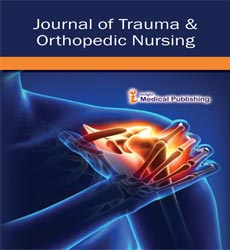Pain Management Protocols in Orthopaedic Trauma Nursing: Balancing Efficacy and Safety
Emily Johnson*
Department of Nursing, University of Manchester, Manchester, United Kingdom
Received date: January 02, 2025, Manuscript No. ipton-25-20822; Editor assigned date: January 04, 2025, PreQC No. ipton-25-20822 (PQ); Reviewed date: January 15, 2025, QC No. ipton-25-20822; Revised date: January 20, 2025, Manuscript No. ipton-25-20822 (R); Published date: January 27, 2025, DOI: 10.36648/ipton.8.1.113
Citation: Johnson E (2025) Pain Management Protocols in Orthopaedic Trauma Nursing: Balancing Efficacy and Safety. J Trauma Orth Nurs Vol.8 No.1: 113.
Introduction
Pain is one of the most pressing challenges in orthopaedic trauma care, profoundly affecting physical recovery, psychological well-being, and quality of life. For nurses, managing pain in patients with fractures, dislocations, and musculoskeletal injuries requires a balance between effective relief and patient safety. Over- or under-treatment can delay rehabilitation, increase complication risks, or contribute to long-term dependency issues. This article explores pain management protocols in orthopaedic trauma nursing, highlighting strategies that achieve efficacy while ensuring safety. Trauma-related pain is not only distressing but also detrimental to healing. Poorly managed pain may impair mobility, delay wound healing, and elevate the risk of chronic pain syndromes. Orthopaedic trauma nurses recognize that timely and effective pain control promotes early mobilization, reduces anxiety, and improves patient outcomes. Pain management thus becomes an essential part of holistic nursing care [1].
Description
Accurate assessment is the cornerstone of effective pain management. Nurses employ validated tools such as the Visual Analog Scale (VAS) or Numeric Rating Scale (NRS) to evaluate pain intensity. Beyond numeric scoring, assessment includes understanding the painâ??s natureâ??sharp, dull, neuropathicâ??and its impact on function. Regular reassessment ensures that interventions remain aligned with evolving patient needs. Opioids remain a mainstay for managing severe orthopaedic trauma pain, particularly in the immediate postoperative or acute injury phase. Nurses administer these agents under strict protocols to minimize risks such as respiratory depression, sedation, and dependency. Careful titration, monitoring for side effects, and adherence to prescribing guidelines are essential to balance analgesic efficacy with patient safety. Non-opioid analgesics, including acetaminophen and nonsteroidal anti-inflammatory drugs (NSAIDs), are integral to multimodal protocols. These agents provide effective baseline pain control and reduce the need for high-dose opioids [2].
However, nurses must remain vigilant regarding gastrointestinal, renal, or cardiovascular side effects, especially in elderly or comorbid patients. Adjusting regimens based on patient risk profiles enhances safety. Regional blocks and local anesthetics, such as femoral nerve blocks or continuous wound infiltration, provide targeted relief with minimal systemic side effects. Orthopaedic nurses monitor patients receiving these interventions for complications like motor weakness, numbness, or infection at catheter sites. The use of regional anesthesia is increasingly recognized as an effective strategy within enhanced recovery protocols [3].
In addition to medications, non-pharmacological techniques play a vital role in pain management. Nurses employ methods such as cold therapy, positioning, relaxation exercises, and guided breathing. These strategies, while sometimes underutilized, can significantly reduce discomfort, empower patients, and complement pharmacological treatments. Incorporating holistic approaches aligns with patient-centered care principles. Not all patients experience pain in the same way; factors such as age, comorbidities, psychological state, and type of injury influence pain perception. Orthopaedic trauma nurses tailor protocols to individual needs, adjusting dosages, combining therapies, and addressing patient concerns. Personalized care not only enhances efficacy but also builds trust and improves patient satisfaction [4].
The dual goals of effective relief and safety require careful monitoring and communication. Nurses play a key role in detecting early signs of complications such as opioid toxicity, NSAID-related bleeding, or inadequate pain control leading to immobility. Documentation and timely reporting to physicians ensure that treatment plans are adjusted without compromising safety disciplines. Pain management in orthopaedic trauma is inherently multidisciplinary, involving surgeons, anesthesiologists, physiotherapists, and pharmacists. Nurses act as central communicators, providing real-time patient feedback that informs collaborative decision-making. This teamwork ensures that interventions are evidence-based, comprehensive, and consistent with best practices in trauma care [5].
Conclusion
Pain management in orthopaedic trauma nursing is both a science and an art, requiring vigilance, adaptability, and compassion. By combining pharmacological and non-pharmacological strategies, nurses ensure that patients achieve meaningful relief without undue risks. Their role in assessment, individualized care, and interdisciplinary collaboration bridges the gap between efficacy and safety. As protocols evolve, orthopaedic nurses remain at the forefront of advancing pain management practices that enhance recovery, mobility, and quality of life.
Acknowledgement
None.
Conflict of Interest
None.
References
- Falck-Ytter Y, Francis CW, Johanson NA, Curley C, Dahl OE, et al. (2012). Prevention of VTE in orthopedic surgery patients: Antithrombotic therapy and prevention of thrombosis: American College of Chest Physicians evidence-based clinical practice guidelines. Chest141: e278S-e325S.
Google Scholar Cross Ref Indexed at
- Eikelboom JW, Karthikeyan G, Fagel N, Hirsh J (2009). American association of orthopedic surgeons and American College of Chest Physicians guidelines for venous thromboembolism prevention in hip and knee arthroplasty differ: What are the implications for clinicians and patients?. Chest135: 513-520.
Google Scholar Cross Ref Indexed at
- Belo JN, Berger MY, Reijman M, Koes BW, Biermaâ?Zeinstra SMA. (2007). Prognostic factors of progression of osteoarthritis of the knee: A systematic review of observational studies. Arthritis Rheumatol57: 13-26.
Google Scholar Cross Ref Indexed at
- Chan H. (2001). Effects of injection duration on siteâ?pain intensity and bruising associated with subcutaneous heparin. J Adv Nurs35: 882-892.
Google Scholar Cross Ref Indexed at
- Robb DM, Kanji Z. (2002). Comparison of two needle sizes for subcutaneous administration of enoxaparin: Effects on size of hematomas and pain on injection. Pharmacotherapy22: 1105-1109.
Open Access Journals
- Aquaculture & Veterinary Science
- Chemistry & Chemical Sciences
- Clinical Sciences
- Engineering
- General Science
- Genetics & Molecular Biology
- Health Care & Nursing
- Immunology & Microbiology
- Materials Science
- Mathematics & Physics
- Medical Sciences
- Neurology & Psychiatry
- Oncology & Cancer Science
- Pharmaceutical Sciences
